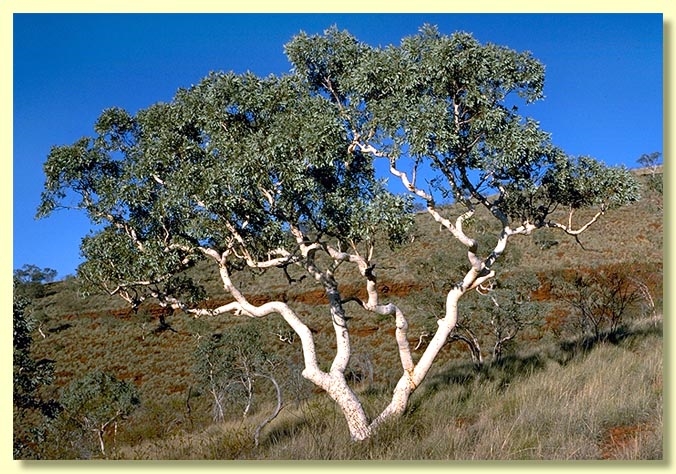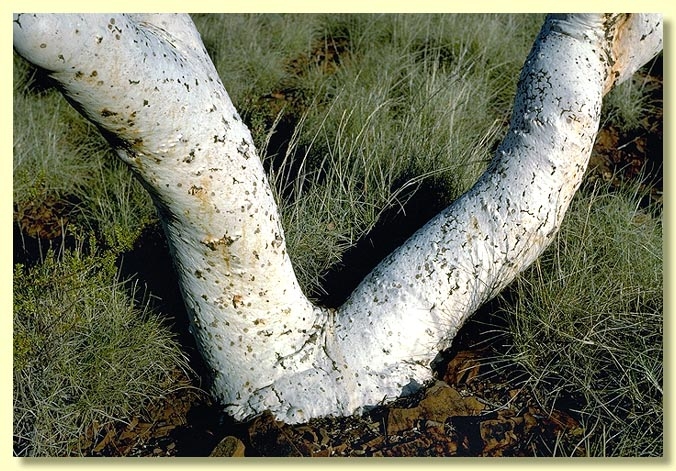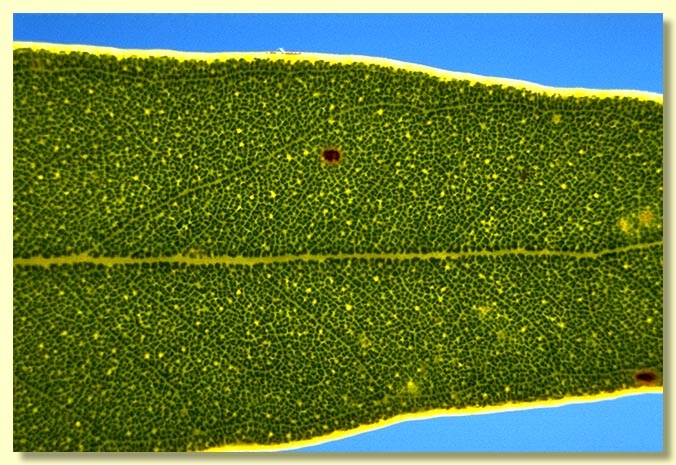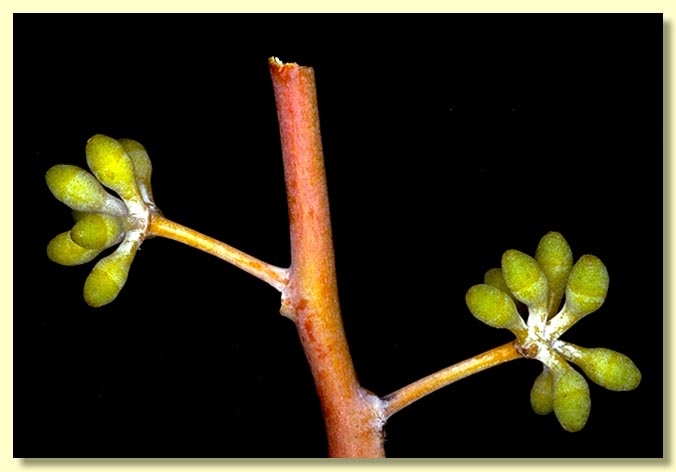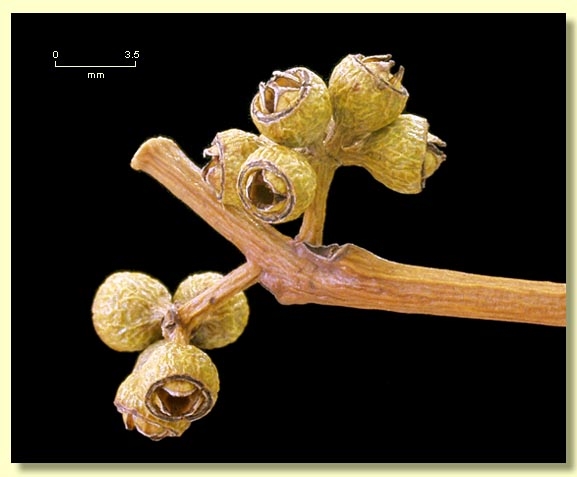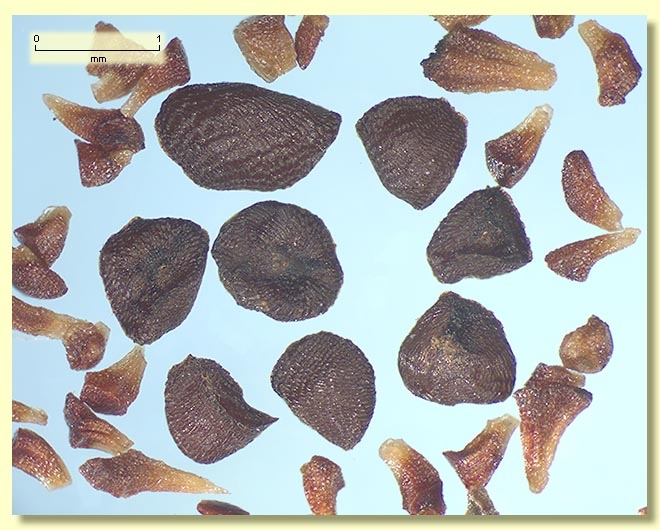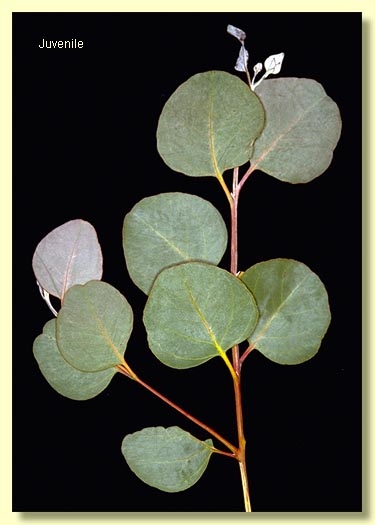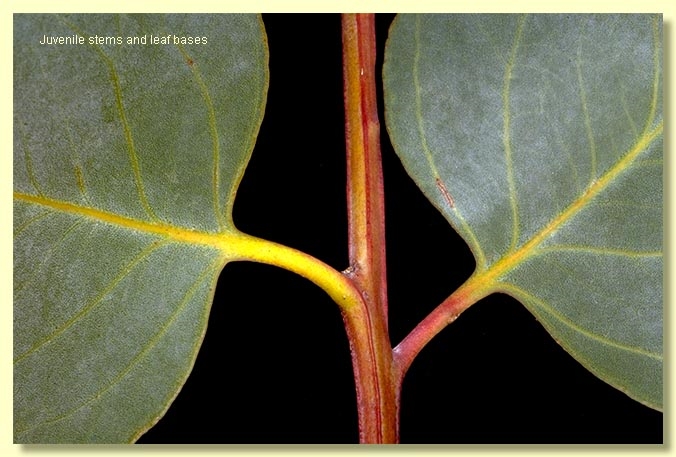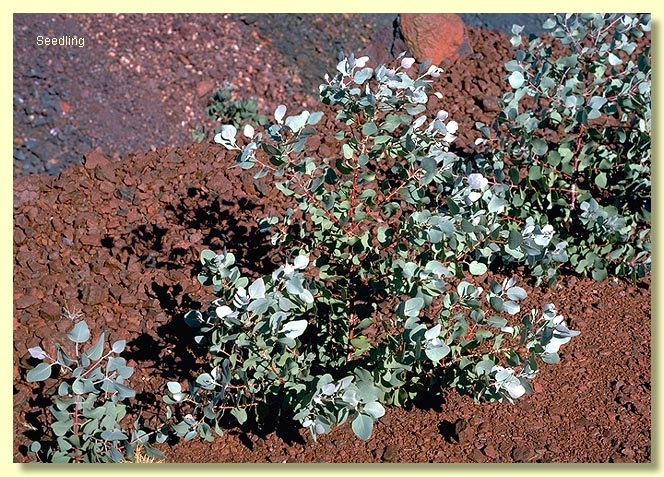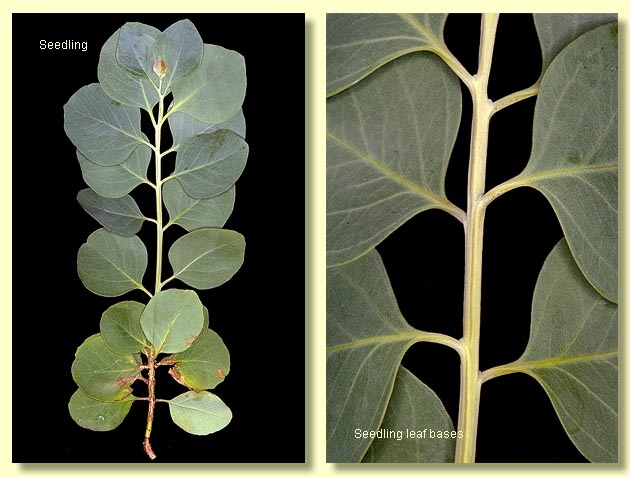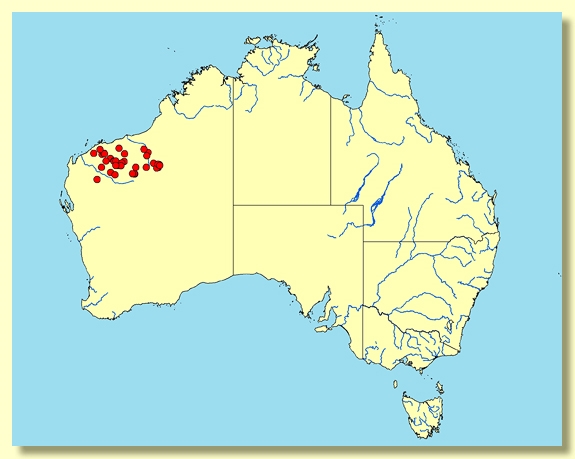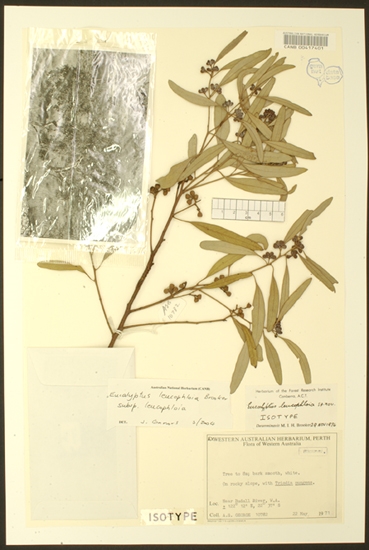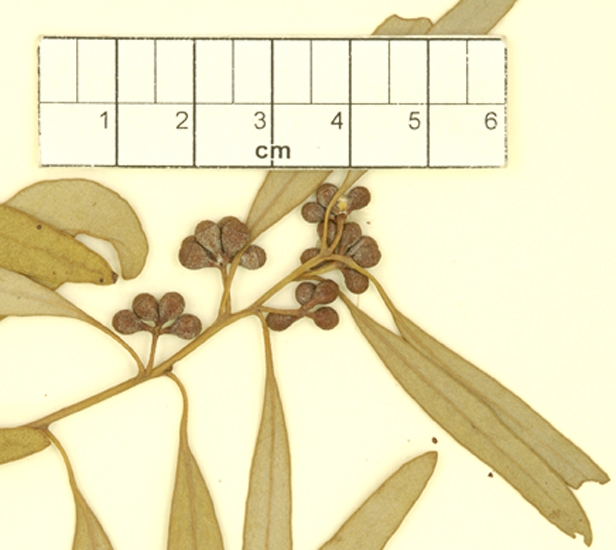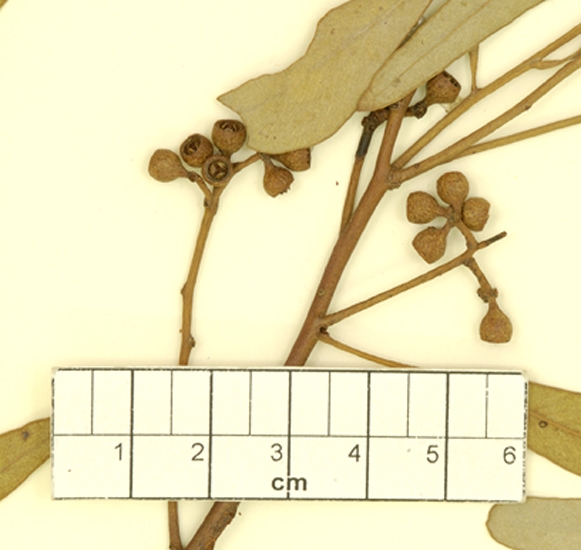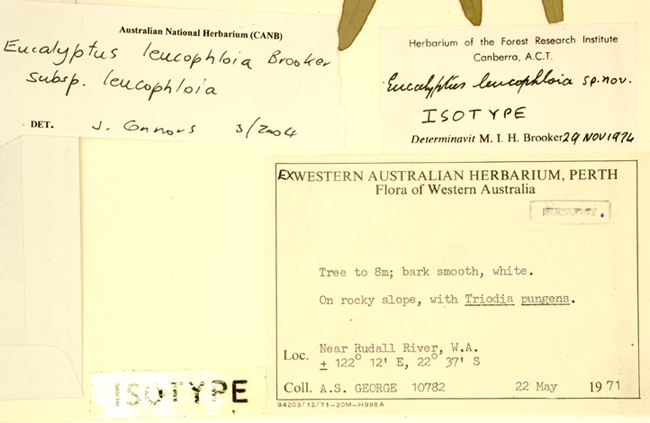Euclid - Online edition
Eucalyptus leucophloia subsp. leucophloia
Eucalyptus | Symphyomyrtus | Platysperma
Eucalyptus leucophloia Brooker, Nuytsia 2: 112 (1976) subsp. leucophloia
T: near Rudall River, W.A., 22° 37’S 122° 12’E, 22nd May 1971, A.S.George 10782; holo: PERTH, iso: CANB, NSW.
Tree to 10 m tall, sometimes smaller and mallee-like. Forming a lignotuber.
Bark smooth and powdery throughout, new bark pale pink to pale orange, maturing to white and then weathering in patches to dark pink or grey. Branchlets sometimes glaucous.
Juvenile growth (coppice or field seedlings to 50 cm): stems square in cross-section, forming small wings at the edges, glaucous; juvenile leaves always petiolate, opposite to alternate, ovate to deltoid to ± orbicular, 3.2–7 cm long, 3–8.5 cm wide, base rounded to truncate to shallowly lobed, blue-grey to glaucous.
Adult leaves usually alternate, occasionally sub-opposite, petioles 0.7–2 cm long; blade lanceolate to ovate, 4–8.5 cm long, 0.9–2.3 cm wide, base tapering to petiole, margin entire, apex pointed, concolorous, dull, green to grey-green to blue-grey to glaucous, side-veins at an acute or wider angle to the midrib, reticulation dense to very dense, intramarginal vein close to margin, oil glands apparently absent or scattered and intersectional.
Inflorescence axillary unbranched, peduncles 0.6–1.2 cm long, buds per umbel 7 to rarely more than 7, shortly pedicellate (pedicels 0.1–0.3 cm long). Mature buds glaucous or non-glaucous, ovoid, 0.3–0.7 cm long, 0.3–0.5 cm wide, often with a well defined constricted ring where the operculum joins the hypanthium, scar present, operculum rounded to bluntly conical to rarely shortly beaked (0.2–0.35 cm long), stamens irregularly inflexed, anthers oblong, versatile, dorsifixed, dehiscing by longitudinal slits, style long and straight, stigma blunt, locules 3(4), the placentae each with 6 or more vertical rows of ovules. Flowers white.
Fruit shortly pedicellate (pedicels 0.1–0.2 cm long), cup-shaped to barrel-shaped to hemispherical, glaucous to non-glaucous, 0.2–0.5 cm long, 0.4–0.6 cm wide, disc narrow, level to obliquely descending, valves 3(4), enclosed or near rim level, rarely slightly exserted.
Seeds brown to yellowy brown, 1–2 mm long, flattened-ovoid, dorsal surface shallowly reticulate, edge of seed smooth, hilum ventral.
Cultivated seedlings (measured at ca node 10): cotyledons bilobed, often only shallowly indented at the apex; stems square in cross-section, glaucous; leaves always petiolate, opposite, deltoid to orbicular to rarely ovate, 3–6.5 cm long, 3.2–6.2 cm wide, dull, concolorous, grey-green to glaucous.
Flowering has been recorded in March, May, July, August and September.
Eucalyptus leucophloia is a small to medium-sized tree species, with two disjunct populations, one endemic to Western Australia found in the Pilbara to Rudall River area (E. leucophloia subsp. leucophloia); and the other in Norther Territory snd Queensland, from Victoria River Downs east to Wauchope, Mt Isa, Cloncurry and Dajarra area (E. leucophloia subsp. euroa). The species is characterised by stunted tree habit, smooth white powdery bark, dull leaves, small buds and fruit with a narrow descending disc. Common on the low stony hills or gravelly sandplains of both areas.
In the classification of Brooker (2000) Eucalyptus leucophloia belongs in a group of species (Eucalyptus section Platysperma) that is distinguished by having smooth bark, very dense reticulation in the adult leaves and flattened-ovoid, yellow-brown to dark brown seeds, shallowly reticulate surface with a ventral hilum. The other members of this group are E. kenneallyi, E. umbrawarrensis, E. rupestris, E. confluens, E. brevifolia and E. ordiana.
There are two subspecies of E. leucophloia.
E. leucophloia subsp.leucophloia
Distinguished from subsp. euroa by the valves of the fruit, which are usually enclosed or near the rim of the fruit; restricted to the Pilbara region.
E. leucophloia subsp. euroa
Distinguished from subsp. leucophloia by the prominent exserted valves of the fruit; restricted to the Northern Territory east from the Victoria River region to the Gulf of Carpentaria hinterland in north-western Queensland.
Within this group, E. leucophloia is closely related to E. brevifolia and can be distinguished by its narrow, flat to descending disc of the fruit. (E. brevifolia has a broad, flat to ascending disc.) E. leucophloia is separated from E. umbrawarrensis and E. confluens by its dull adult leaves (glossy in E. umbrawarrensis and E. confluens). E. rupestris and E. kenneallyi differ by having cylindrical to cup-shaped, smaller fruit, usually 0.4 cm or less (hemispherical to cup-shaped and usually 0.4 cm or greater in E. leucophloia) and the umbel peduncle length (usually 0.5 cm or greater in E. leucophloia and 0.5 cm or less in E. kenneallyi and E. rupestris). E. ordiana differs by retaining its broad juvenile foliage through to the adult crown (the mature crown leaves usually sub-opposite to alternate and greater than 3 cm wide in E. ordiana and more or less alternate and less than 3 cm wide in E. leucophloia).
Within its area of occurrence, the populations of E. leucophloia do not overlap with any other closely related white gums. However, in the Northern Territory, nearby populations of E. apodophylla, E. cupularis, E. gregoriensis and E. herbertiana may be confused with E. leucophloia.
E. apodophylla is distinguished by having relatively large, opposite leaves in the mature crown (usually >4 cm wide in E. apodophylla but much smaller, usually narrower than 4 cm wide and alternate in E. leucophloia). E. cupularis and E. herbertiana are distinguished by having long lanceolate leaves (usually longer than 10 cm in E. cupularis and E. herbertiana but broadly lanceolate to ovate and less than 10 cm in E. leucophloia). E. gregoriensis is three-budded in each umbel. (E. leucophloia is seven-budded.)
In the Pilbara region of Western Australia, there are no other white gums closely related to E. leucophloia. The only other species in the Pilbara with completely smooth, white, powdery bark similar to E. leucophloia are: C. aspera, C. candida, C. ferriticola, E. camaldulensis and E. victrix.
C. aspera, C. candida and C . ferriticola are all ghost gums and are easily separated by their fruit, which are more or less cylindrical in shape and always thin-walled with enclosed disc and valves. C. aspera and C. candida can be further distinguished by having cordate and usually scabrid mature crown leaves. E. camaldulensis is a widespread red gum along watercourses also white-barked and possibly could be confused with E. leucophloia. It is usually a much larger tree and can be further separared by its fruit, which usually has a broad ascending disc with prominently exserted valves and cuboid yellow seed with a terminal hilum. (The disc in E. leucophloia is narrow and descending and the seed is flattened-ovoid with a ventral hilum.) E. victrix is smooth- and white-barked species of arid lands and can be easily distinguished by having terminal inflorescences (always axillary in E. leucophloia).
Eucalyptus leucophloia: Greek leuco-, white and phloios, the bark.

